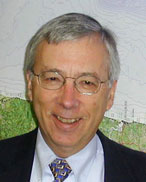Partner Profile: Oregon Department of Land Conservation and Development —September 2005
Oregon is a special COASST region. Although Oregon beaches represent less than 10% of COASST sites, they account for almost 40% of all carcasses found annually. Because so many seabirds breed in Oregon, COASST beached bird data are a vital “early warning system” that can alert natural resource management agencies to environmental change or threats.

Bob Bailey, Oregon Department of Land Conservation and Development (ODLCD)
As the agency primarily responsible for the manage-ment of coastal ecosystems, the Oregon Department of Land Conservation and Development partners with COASST to help conserve Oregon’s ocean resources for future generations. According to Bob Bailey, Manager of the Ocean/Coastal Services Division (better known as the Oregon Coastal Management Program), COASST brings “multiple benefits” to the agency.
“In addition to contributing data that help us better understand and manage coastal resources, COASST involves the public and gives citizens the opportunity to observe the marine environment,” Bailey explains. “If people understand our coastal resources, they are more likely to be good stewards and advocates. So, in return for a modest amount of funds, we receive good data, citizen involvement and public stewardship. That is a pretty good deal.”
Bailey says the Oregon Coastal Management Program is best described as “the hub of a giant wheel of activities that affect the Oregon coast.” The program includes the land use planning authorities of all coastal cities and counties in the state, and it provides technical and funding assistance to local governments to help plan and manage land uses that affect coastal resources. Bailey’s team works closely with the Oregon Parks and Recreation Department, the Department of Fish and Wildlife and other state and federal agencies working to protect the Oregon coast, including the US Fish and Wildlife Service Coastal Refuges.

Heceta Head Lighthouse and Devil’s Elbow Beach near Florence, Oregon (Colin French)
Given the Oregon Coastal Management Program’s broad range of partners and stakeholders, it isn’t surprising that sound citizen science is a component of its approach to resource management. “Citizens clearly have a role to play, but it must be done in a structured way that will withstand scientific scrutiny and objectivity,” Bailey says. “The trick is finding the particular methods that will add scientific value while engaging the public. COASST is a path-breaking example of how to do that.”
A veteran manager of marine resources, Bailey encourages citizens to get involved with programs like COASST and become educated about ocean issues. The first challenge we face, Bailey says, is the increasing pressures on coastal ecosystems due to the cumulative effects of human activities at a local, regional, and global scale. “Humans, despite their best intentions, continue to pluck at various threads of these complex ecosystems, and when they unravel, they can do so in a hurry and in most unexpected ways.”
The second basic challenge, according to Bailey, is to understand coastal marine ecosystems so that managers can respond to changes in ways that minimize additional adverse effects. However, he acknowledges that this is easier said than done. “Society cannot afford to wait to fully understand how these systems work in order to protect them; we must take action now.”
Bailey believes the COASST program is a key opportunity for citizens, scientists, agencies and other stakeholders to join forces and take meaningful action to protect marine ecosystems. “Anyone who has ever walked the beach has seen dead seabirds. But to see them as data points about formerly live birds that lived in a certain way in the marine environment can change people’s perceptions about the birds, their environment and how science is conducted,” Bailey says. “I am very pleased to support COASST and help expand its mission to the Oregon coast.”